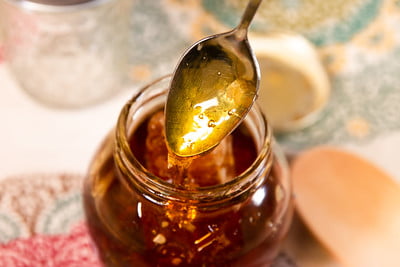Nectar Honey: What it Is and Why It Matters
Honey, often regarded as liquid gold, is a complex natural product derived from the nectar of flowers. But how exactly does nectar become honey? This transformation involves a fascinating combination of biological processes that make honey a unique and valuable food. In this article, we will explore nectar honey in-depth, answering key questions and offering insights backed by science, culinary trends, and real-world experience.

Source https://flic.kr/p/2nG59zw
What is Nectar Honey?
Nectar honey originates from the nectar of flowering plants. When bees gather nectar, they don’t simply store it as-is. Instead, the nectar undergoes a remarkable transformation inside the bee, involving enzymes that break down complex sugars into simpler ones. This chemical process makes honey easier to digest and enhances its preservation.
Bees collect nectar using their long tongues, which they insert into the flower to extract the sweet liquid. Once inside the bee’s honey stomach, enzymes mix with the nectar, breaking sucrose into glucose and fructose. After returning to the hive, bees deposit the nectar into wax cells, and through evaporation, it becomes honey. This intricate process ensures that nectar, originally 80% water, becomes a supersaturated solution with only about 18% water, which helps prevent spoilage.
Is Nectar Better Than Honey?
Nectar and honey are distinct, yet closely connected substances. Nectar is the raw ingredient, and honey is the finished product. While nectar is rich in water and primarily composed of sucrose, honey contains fructose, glucose, and trace amounts of other sugars, minerals, vitamins, and enzymes. Nutritionally, honey is far superior to nectar due to its concentrated sugars and beneficial compounds like antioxidants.
Additionally, honey has natural antibacterial properties and a lower glycemic index than table sugar, making it a healthier option for sweetening foods. So, while nectar is vital for bees, honey is far better suited for human consumption, offering energy and medicinal benefits.
Is Honey Just Nectar?
No, honey is not just nectar. The transformation from nectar to honey is a biochemical process facilitated by bees. Nectar, while sweet, is watery and lacks the complexity of honey. The enzymes bees add to nectar break down sucrose into glucose and fructose, giving honey its rich flavor and extended shelf life. Furthermore, the evaporation process in the hive concentrates the sugars, which not only thickens the honey but also reduces its water content, making it stable and resistant to spoilage.

What is Nectar Made Of?
Nectar is a sugary liquid secreted by plants, composed mostly of water and sucrose, but it also contains smaller amounts of glucose, fructose, proteins, and organic acids. Its primary role is to attract pollinators like bees, which use it as a food source. Nectar’s sugar concentration can vary depending on the plant species, and this variance plays a significant role in the final flavor and texture of the honey produced.
How Do Bees Turn Nectar into Honey?
Bees are natural chemists, using enzymes and dehydration to transform nectar into honey. The process starts when a bee gathers nectar from flowers. During flight, bees secrete an enzyme called invertase, which breaks down sucrose into simpler sugars—glucose and fructose. These sugars are more digestible for bees and humans alike.
Back at the hive, the nectar is passed between bees, and additional enzymes are added, further breaking down the sugars. The bees then fan the nectar in the honeycomb with their wings, promoting evaporation. This evaporation reduces the water content to about 18%, creating the thick, viscous substance we know as honey. When ready, the bees seal the honeycomb with wax to preserve it, much like how humans seal jars of jam to keep them fresh.
The Effort Behind Honey Production
The production of honey is a labor-intensive process for bees. To produce just one kilogram of honey, a bee colony must visit over 1.6 million flowers and travel around 140,000 kilometers. It’s an astounding feat that highlights the intricate cooperation and efficiency of a bee colony. Every spoonful of honey you consume is a testament to the hard work of thousands of bees.
The Role of Monofloral Honey
Monofloral honey, derived from the nectar of a single type of flower, offers unique flavor profiles based on the flower’s origin. Examples include lavender, clover, and acacia honey, each providing distinct tastes and aromas. Much like wine, the floral source of honey can dramatically influence its flavor, texture, and even color. Monofloral honey is often prized by chefs and food enthusiasts for its purity and distinctive characteristics, making it an essential ingredient in gourmet cuisine.
Honey in Culinary Arts
In recent years, honey has gained popularity among top chefs worldwide for its versatility and flavor-enhancing properties. From honey-glazed meats to honey-infused desserts, this natural sweetener has been used to add depth to both sweet and savory dishes. Chef René Redzepi of Noma famously used forest honey to glaze wild duck, while chef Christina Tosi’s honeycomb brittle brought a delightful crunch to her cakes at Milk Bar.
Conclusion
Honey is much more than just nectar; it is a product of nature’s remarkable processes and a testament to the power of collaboration between bees and plants. Its complex flavor, nutritional benefits, and culinary versatility make it a staple in kitchens and homes around the world. Whether you’re drizzling it on toast or using it in gourmet dishes, honey brings a touch of nature’s magic to your table.
Resources:
- National Honey Board. (1995). Carbohydrates and the Sweetness of Honey.
- Firestone, CO. (2005). Honey: A Reference Guide to Nature’s Sweetener.
- The Ohio State University College of Food, Agricultural, and Environmental Sciences. (2014). Chemistry of Honey.
- Kappico, Jenifer T., et al. Is Honey the Same as Sugar? University of Arizona Cooperative Extension. AZ1577 (2012).
- Viuda-Martos, Manuel, et al. (2010). Aroma Profile and Physical-Chemical Properties of Artisanal Honey from Tabasco, Mexico.
- Food Science News: “Honey – A Nutritional Powerhouse.” (2023).
- Bee Keeping Forum: Discussions on Monofloral Honey Varieties (2023).
